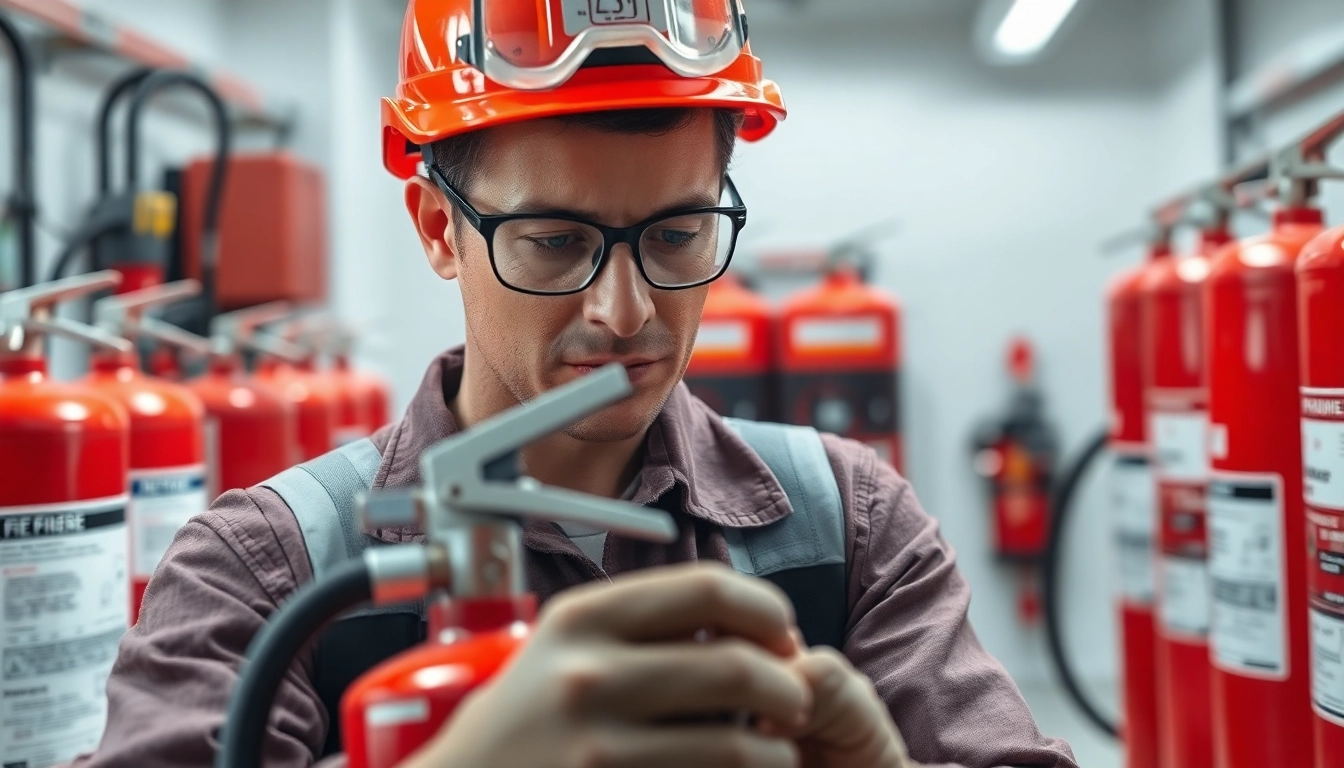Comprehensive Guide to Fire Extinguisher Servicing and Maintenance Strategies

Understanding Fire Extinguisher Servicing
Fire extinguishers are crucial lifesaving devices that play a pivotal role in fire safety within residential, commercial, and industrial settings. Despite their importance, many people are unaware of the necessary steps for fire extinguisher servicing. Knowledge about fire extinguisher servicing goes beyond simply knowing how to use them; it involves understanding maintenance protocols that ensure they function correctly in an emergency.
Importance of Fire Extinguisher Servicing
The significance of regular fire extinguisher servicing cannot be overstated. An unserviced fire extinguisher may not work when needed, leading to disastrous consequences. Regular maintenance not only ensures compliance with fire regulations but also enhances the safety of occupants. According to the National Fire Protection Association (NFPA), extinguishers should be visually inspected monthly and undergo professional servicing annually. This ongoing commitment to fire safety can prevent significant injury or loss of life in case of a fire emergency.
Types of Fire Extinguishers and Their Servicing Requirements
There are several types of fire extinguishers, each designed for specific kinds of fires. The most common types include:
- Water Extinguishers: Best for Class A fires, which involve ordinary combustibles such as wood and paper.
- Chemical Foam Extinguishers: Suitable for both Class A and B fires, useful against flammable liquids.
- Dry Powder Extinguishers: Effective on Class A, B, and C fires, making them versatile for various scenarios.
- Carbon Dioxide (CO2) Extinguishers: Ideal for Class B and electrical fires.
- Wet Chemical Extinguishers: Designed for Class K fires, especially for cooking oils and fats.
Each type of extinguisher requires specific servicing protocols. For example, dry chemical extinguishers should be serviced annually, while CO2 extinguishers often need hydrostatic testing every five years.
Legal Regulations and Standards for Fire Extinguisher Maintenance
Prominent regulations govern fire extinguisher servicing. NFPA 10 outlines the minimum inspection and maintenance requirements for extinguishers in the United States. Key legal standards include:
- Installation Standards: Fire extinguishers must be placed in accessible locations, usually within 75 feet of potential fire hazards.
- Inspection Frequency: Monthly visual inspections are mandated, while comprehensive servicing by a licensed technician is required annually.
- Documentation: All inspections and services must be documented clearly, with records kept for review.
Failing to comply with these regulations can result in penalties, not to mention compromises to safety. Therefore, understanding these legal requirements is vital for all property owners.
How to Perform Basic Fire Extinguisher Servicing
Step-by-Step Inspection Checklist
Regular inspections of fire extinguishers are essential for ensuring they are functional when needed. A systematic approach will enhance effectiveness. Here’s a detailed checklist for inspecting fire extinguishers:
- Check Accessibility: Ensure the extinguisher is in an accessible location and not obstructed.
- Inspect the Pressure Gauge: The needle should be in the green zone indicating the extinguisher is charged.
- Look for Physical Damage: Examine the cylinder for any signs of rust, dents, or leaks.
- Check the Nozzle: Ensure it’s clean and free from obstructions.
- Verify Inspection Tag: Check that the inspection tag is current and signed by the technician who last serviced it.
Common Issues to Look for During Servicing
During inspection, several potential issues can arise:
- Low Pressure: If the gauge indicates low pressure, the extinguisher needs recharging.
- Corrosion: Rust or corrosion can compromise the integrity of the extinguisher.
- Expired Tag: Ensure that service tags are up-to-date; an expired tag suggests the extinguisher has not been serviced in compliance with regulations.
- Physical Damage: Any visible cracks, leaks, or loss of parts can render an extinguisher ineffective.
When to Replace a Fire Extinguisher
Knowing when to replace a fire extinguisher is vital for maintaining safety. General guidelines include:
- Expiry of the service tag, typically after six years for many units.
- Physical damage that compromises its ability to function properly.
- Loss of pressure, which cannot be remedied by recharging.
- Older models that do not have the latest safety features or are no longer compliant with regulations.
Advanced Fire Extinguisher Maintenance Techniques
Recharging Procedures and Frequency
Recharging fire extinguishers is a critical aspect of maintaining their readiness. Symbols indicating recharging are typically displayed on the unit itself. Generally, extinguishers should be recharged if:
- The pressure gauge is not in the green zone.
- The extinguisher has been used, even partially.
- At least every six years for stored pressure extinguishers.
The recharging process involves professional service to ensure the unit is filled with the appropriate extinguishing agent and is functioning efficiently.
Six-Year Maintenance Requirements
Six-year maintenance requirements apply predominantly to stored pressure extinguishers. This process also includes a thorough internal examination and recharging if necessary. For these service checks, it’s best to rely on certified professionals to ensure compliance and safety. Key aspects of this maintenance include:
- Performing a thorough internal inspection of components.
- Replacing seals and other components as needed.
- Recharging following the completion of maintenance checks.
Hydrostatic Testing Explained
Hydrostatic testing is a procedure used to assess the integrity and performance of fire extinguishers. This testing typically occurs every five to 12 years, depending on the type of extinguisher. Here’s how it works:
- The extinguisher is filled with water or another hydraulic fluid.
- Pressure is applied to test for leaks and verify the ability to withstand high pressure.
- If the extinguisher fails the test, it is typically retired from service and replaced.
Finding Professional Fire Extinguisher Servicing
Choosing the Right Service Provider
Selecting a qualified service provider for fire extinguisher servicing is crucial. Important considerations include:
- Certification: Ensure technicians have the necessary certifications, ideally from organizations like the NFPA.
- Experience: Look for a provider with a proven track record in fire protection.
- Reputation: Research reviews and testimonials from previous clients to gauge reliability.
Evaluating Service Contracts and Agreements
When engaged in discussions with service providers, understanding the terms outlined in contracts is essential. Key components to look for include:
- Scope of services provided.
- Frequency of inspections and maintenance.
- Clear details regarding costs and payment structures.
- Terms regarding emergency servicing or recharging.
Understanding Costs Associated with Fire Extinguisher Servicing
The costs associated with fire extinguisher servicing can vary widely based on several factors, including:
- The type and number of extinguishers to be serviced.
- The frequency of required maintenance and inspections.
- Local regulations and the rates charged by service providers.
Understanding these elements helps businesses budget better and prioritize safety measures accordingly.
Best Practices for Ongoing Fire Safety Compliance
Developing a Fire Safety Plan
Creating a robust fire safety plan is essential for any property owner. This plan should encompass:
- Emergency evacuation routes and procedures.
- Designating specific roles for staff during a fire incident.
- Regular training sessions regarding extinguisher use and safety protocols.
Training Employees on Fire Extinguisher Use
Regular training is necessary to empower employees on how to use fire extinguishers. Training sessions might include:
- Understanding the different types of fires and extinguishers.
- Hands-on demonstration of extinguisher use.
- Regular refresher courses to keep fire safety at the forefront of employees’ minds.
Regular Check-Up and Maintenance Scheduling
Implementing a routine check-up and scheduling regular maintenance can be beneficial for compliance and safety. This might involve:
- Establishing a monthly inspection calendar.
- Using checklists to document findings from routine inspections.
- Setting reminders for servicing and recharging based on manufacturer recommendations and legal requirements.



Leave a Comment